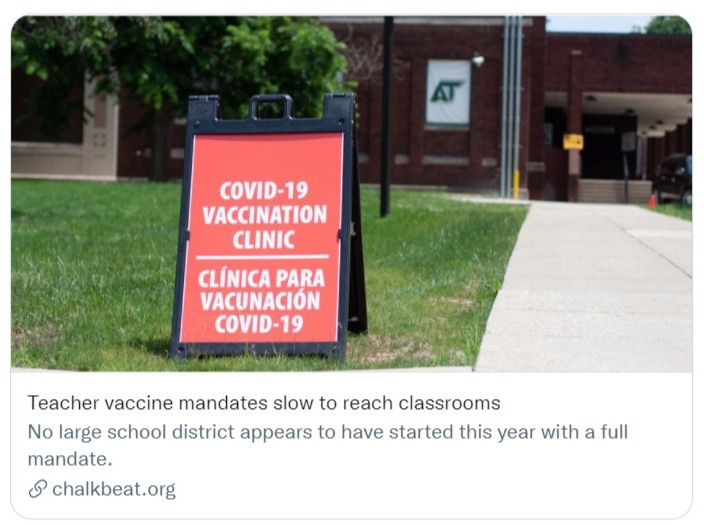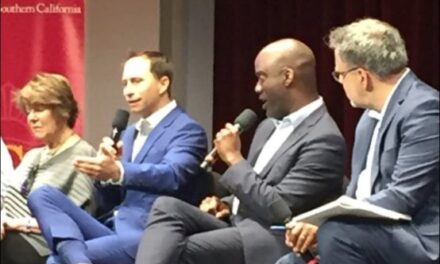Neither silver bullets nor inevitable disasters, COVID vaccine mandates are messy measures that require careful coverage. Five questions about timelines, exemptions, and data are key factors.
By Alexander Russo
On Friday afternoon, California Governor Gavin Newsom announced that he was going to establish a statewide vaccine mandate for students.
The news coverage came fast and furious, much of it focused on Newsom’s claim to being “first in the nation” to require students to be vaccinated in order to attend school.
The AP story about the announcement went on to describe the governor as “one of the most aggressive governors on coronavirus restrictions.”
What few seemed to notice or emphasize, however, was that Newsom’s plan was chock full of exemptions and potential delays that make it much less likely to be speedy or effective than it might initially appear.
Only a few eagle-eyed journalists seemed to figure that out. The LA Times editorial page called the Newsom mandate “weak tea.” CalMatters’ Dan Walters called it “a political stunt.”
Now, I’m just as much of a fan of school vaccine mandates as anyone else. But vaccine mandate policies don’t necessarily result in immediate increases in school vaccination rates. Nor do they necessarily result in chaos and mass resignations.
That’s why news outlets need to take extra care to ask good questions about school vaccine mandates. “It’s not just the mandate that matters,” notes CRPE’s Christine Pitts, who’s been tracking mandates nationwide. “It’s the accountability and data and reporting that has to be a coordinated effort.”
“It’s not just the mandate that matters,” notes CRPE’s Christine Pitts. “It’s the accountability and data and reporting that has to be a coordinated effort.”

Above: California to require COVID vaccines for children
The evidence seems clear that vaccines help protect individuals and prevent transmission. Historically, vaccine mandates seem to have worked at increasing vaccine rates and making schools safe against outbreaks of other diseases. And the new COVID vaccine mandates seem to be a strong contributor to vaccine uptake in places like New York City where they’ve been mandated.
So it’s no surprise that vaccine mandates are increasingly popular. Oregon and Washington have mandated the COVID-19 vaccine for almost all K-12 school employees, according to a recent rundown in The Conversation. Another seven states require that teachers and other employees either be vaccinated or undergo regular testing.
Districts with some form of school staff vaccine mandate include San Antonio, Los Angeles, Philadelphia, Chicago, and New York City, according to CRPE, which has been tracking the process. Los Angeles, Oakland, Culver City, and San Diego require some or all students to be vaccinated, depending on age and sports activities.
So far, so good. However, a vaccine mandate “isn’t just a switch you flip on and walk away from,” wrote FiveThirtyEight’s Maggie Koerth in a September explainer. It’s a “finicky machine” that requires constant adjustment.
A vaccine mandate “isn’t just a switch you flip on and walk away from,” wrote FiveThirtyEight’s Maggie Koerth. A mandate is “a finicky machine” that requires constant adjustment.

Above: Editorial: Newsom’s school COVID-19 vaccine mandate is weak tea
One of the few outlets to question the Newsom announcement was the L.A. Times editorial page, which claimed that Newsom’s proposal “moves too slowly and carries too little punch.”
That’s because it “doesn’t apply to teachers yet and probably won’t go into effect until next summer,” noted the editorial page. “And it could be easy for families to gain exemptions because of existing state laws.”
CalMatters’ Walters noted that “a first-in-the-nation vaccination announcement doesn’t necessarily mean that California will be the first state to have school kids immunized.”
Last month, Chalkbeat noted that while mandates were increasingly popular among states and districts, implementation and enforcement were lagging behind.
Last month, Chalkbeat noted that while mandates were increasingly popular among states and districts, implementation and enforcement were lagging behind.

Above: Teacher vaccine mandates slow to reach U.S. classrooms
Here are five questions to ask about school vaccine mandates:
Question 1: What are the current COVID vaccination rates for school staff and students, by school, district, or state?
While COVID case data and quarantine information have become widely available, good data on vaccine rates for school staff and students are surprisingly hard to come by, CRPE’s Christine Pitts and Bree Dusseault note.
In a phone interview, Pitts told me that the only state she knows of that has committed to collecting and reporting school vaccine rate information is Maine, which unveiled its intention to collect and report anonymized school-level vaccine rates in an August rollout. See Maine’s school staff vaccine tracker here. See its youth vaccine tracker here.
Some districts like Portland include district-wide vaccine rate information on their dashboard, she said, but for many local school agencies district much less school-level vaccine rate information would be a heavy lift.
Question 2: Does the mandate allow individuals to be tested, rather than vaccinated? Does it allow for religious and medical or philosophical exemptions?
According to FiveThirtyEight, religious beliefs and philosophical beliefs are common exemption categories, though six states have eliminated nonmedical exemptions.
According to CRPE, 40 of the 100 districts it monitors are now requiring staff vaccinations, and 14 of those don’t allow a testing alternative. Vaccine mandates with testing options are much more popular.
Question 3: How quickly is the mandate being implemented, and what are the deadlines?
In some cases, it’s going to be a while before the mandate actually kicks in, unless you take the most optimistic possible interpretation. The Newsom mandate, for example, could take effect as early as January. But there’s no guarantee it will happen that quickly, if at all.
If the FDA doesn’t give final approval of the vaccine for kids younger than 16, that could be a problem. Journalists should be very aware of the difference between vaccine eligibility and having final FDA approval for an age group.
Question 4: How is the mandate going to be monitored and enforced? What are the procedures and penalties for school staff or students who don’t comply?
Schools say they’re going to do all kinds of things and then not do them, and it’s easy for reporters to forget. Verifying that the vaccine mandate is being monitored and enforced will be a key task for oversight agencies and enterprising journalists.
Question 5: What are the legitimate tradeoffs that are involved in implementing a vaccine mandate, in terms of staff and student experiences and school quality?
Like anything, a vaccine mandate is a balancing act between competing needs. In a situation in which some parents might withhold their children from in-person schooling for fear of the vaccine, the balance is between school safety and student access to in-class learning.
“I think you need a good reason … to take that benefit away from people who won’t get vaccinated,” said Seattle Children’s Hospital’s Douglas Diekema in the FiveThirtyEight article.
But that’s not the only tradeoff. Kids that move to private or parochial schools also represent lost income for districts. Teachers who retire or find other work also represent disruptions for students.

Above: N.Y.C.’s Teacher Vaccine Mandate Prompts Thousands of Last-Minute Shots
So far, at least, the school vaccine mandates generally seem to be working, in the sense that they’ve contributed to increased vaccination rates among the mandated groups, withstood various legal and political challenges, and have yet to result in widespread resignations or shortages of school staff.
However, there will be continued challenges and setbacks in some places, depending on local politics, implementation, and enforcement procedures.
Careful, skeptical — but not hostile or alarmist — coverage is needed, so that parents, educators, and policymakers know whether a mandate is full of holes or overly rigid.
ABOUT THE AUTHOR

Alexander Russo
Alexander Russo is founder and editor of The Grade, an award-winning effort to help improve media coverage of education issues. He’s also a Spencer Education Journalism Fellowship winner and a book author. You can reach him at @alexanderrusso.
Visit their website at: https://the-grade.org/












